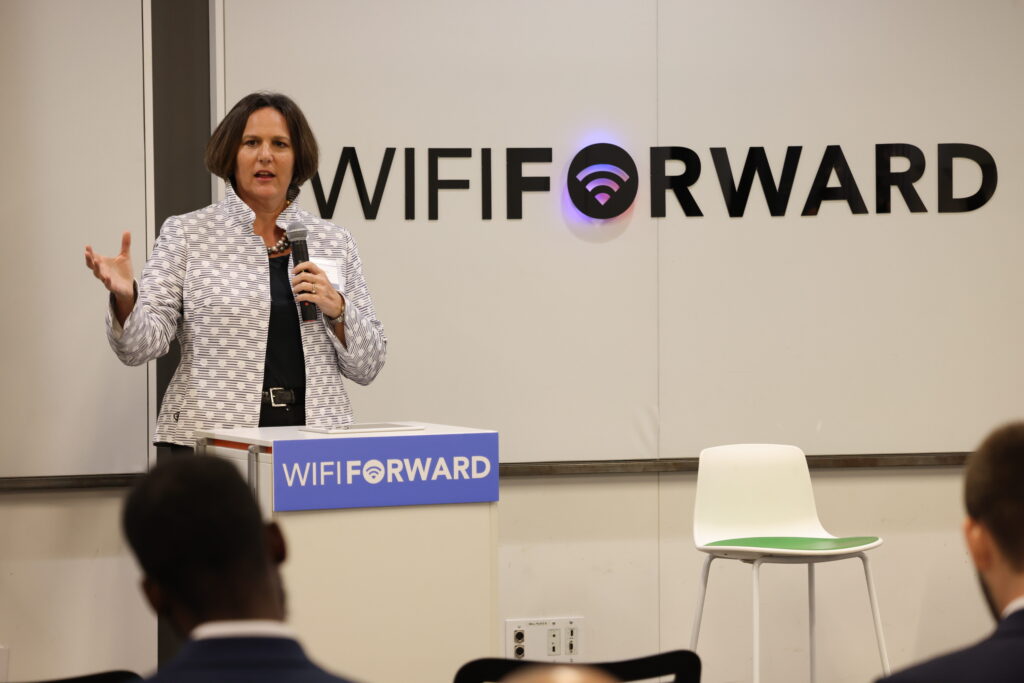Immersive VR classroom experiences. Augmented Reality (AR) and its mixed reality cousin being used on construction sites to mitigate potential errors and increase productivity. Metaverses implemented by the government to deliver public services. XR technologies that sense brainwaves and use eye-tracking to help someone who may not be able to speak or communicate.

Liz Hyman, CEO of the XR Association speaking at WifiForward’s Wi-Fi Summit
These were just a few of the uses Liz Hyman, the CEO of the XR Association, envisioned for the burgeoning world of XR technology. Hyman, who spoke at WifiForward’s Inclusive Spectrum Future event in June, discussed the range of AR, VR and metaverse products that are becoming more popular with consumers and enterprise users — and how Wi-Fi is paramount to their success.
“The key to so much of this will be Wi-Fi,” Hyman said. “The future which includes emerging technologies like XR, AI, machine learning and robotics demonstrate that we need to continue to expand access to the most ubiquitous and widely available broadband.”
The XR industry is developing a number of new applications across a wide range of sectors including simulated workforce training programs and holographic imagery to guide shop floor workers with installations. There are many promising developments, but the performance of these products is contingent on access to the best possible Wi-Fi. These new technologies have the potential to drastically improve our everyday lives, but faster and farther-reaching Wi-Fi will be a necessity in realizing those benefits.
“The existing Wi-Fi bands are not large enough to support the wide 160 MHz channels needed to enable multi-gigabit Wi-Fi 6 technology, or the 320 MHz channels needed for next-generation Wi-Fi 7,” Hyman elaborated. “Thankfully, in 2020, the FCC designated 1,200 MHz of the 6 GHz band — adjacent to the existing 5 GHz band — for unlicensed use. Wi-Fi 6E is faster, more secure, has lower latency, is more reliable and can support even more devices.”
“Future generations of Wi-Fi, bolstered by access to the 6 GHz spectrum, will result in broader scale IoT deployment, great increases in video streaming, and new innovations in AR/VR applications.”
Over the next decade, innovating new XR technologies and expanding broadband networks will provide massive economic benefits, both globally and in the U.S. Last year, the Wi-Fi Alliance released a study estimating that by 2025, the Wi-Fi industry could generate 4 million new jobs while another study released by WifiForward predicted that companies selling AR/VR equipment in U.S. markets look to profit nearly $20 billion in revenue between 2020 and 2025. This increase in cash flow also bodes well for the U.S. GDP.
“The diffusion of AR/VR solutions among U.S. enterprises will yield a spillover contribution to the GDP equivalent to $25.78 billion between 2020 and 2025,” Hyman said. “In fact, the Analysis Group, in partnership with Meta, recently hypothesized that if the metaverse evolves in the same way mobile technology has in terms of adoption — and it seems poised to do so — it would lead to a 2.8% contribution ($3 trillion) to global GDP by 2031.”
The future of XR is ambitious and uncharted, but Hyman knows it’s time for a leap of faith: “The world is ready for W-Fi 6E and, I, for one, am excited to see all of its benefits come to fruition.”
